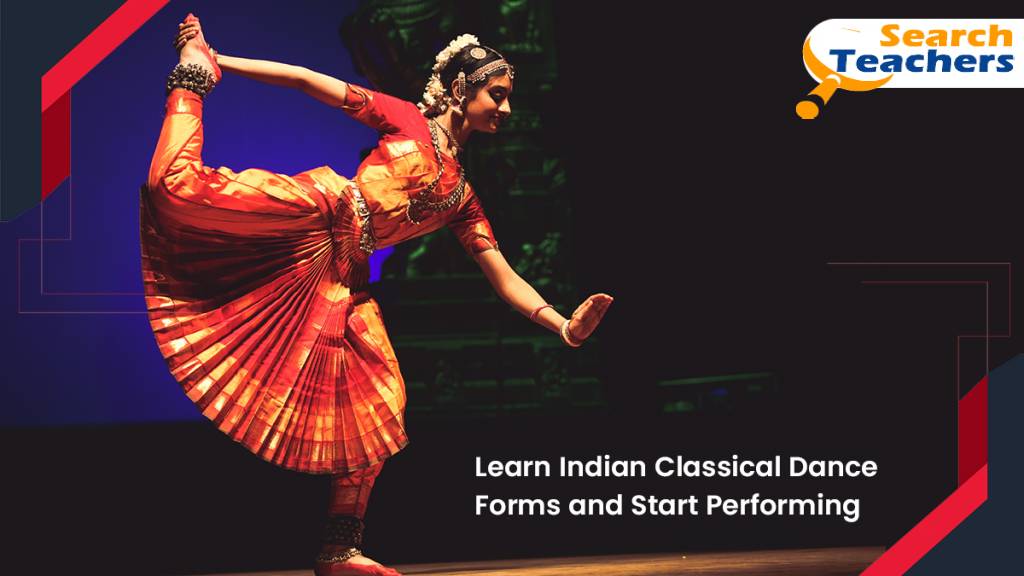
Learn Indian Classical Dance Forms and Start Performing
Classical dances in India are an integral part of the Indian culture and date back to 200 BC. The first compilation of the dance forms was found in Natya Shastra, a Sanskrit text book dedicated to the worship of Hindu deities through dancing. Indian classical dances originated in the temples, as worshipping was the main aim initially. With time, artists started improvising on the movements and the dancing patterns evolved with more flexibility, variations and got acceptance even from the international community at large.
The Ministry of Culture, Government of India, have recognized nine dance forms as classical dance forms and we will go through them one by one.
Bharatnatyam
The most well known Indian classical dance, Bharatnatyam, came from Tamil Nadu and is 2000 years old. Devadasis (women offered to god) used to perform this dance throughout the temples of South India. While dancing you need to have a glamorous make-up with bright attractive costumes and ornaments to keep the audience enthralled in the art. Instruments used in this include Mridangam, Flute, Violin and there are seven repertoires of the dance starting from Alarippu (Invocation) to Padam, thillana and ending with Mangalam. Carnatic music is used in the background in Tamil, Telugu, Kannada and Sanskrit verses. Yamini Krishnamurthy, SarojaVaidyanathan are some of the legends of Bharatnatyam.
Kathak
Kathak comes from North India and revolves around the mythological stories of Ramayana and Mahabharata. It is known for great footwork, spins, chanting and very straight body movements. Dancers wear heavy ghungroos and create a new sound to connect with the audience. There are 4 gharanas of kathak; Jaipur, Lucknow, Raigarh and Benaras. Kathak starts with Vandana (worship of god) and ends with bhajan/thumri. Sari and Ghagra are worn during the performance, not much makeup and the background music is Hindustani Classical Music with instruments like Pakhawaj, tabla, Sarangi etc. ShambhuMaharaj and BirjuMaharaj are some of the legends of Kathak dance.
Odissi
Odissi originated from the Jagannath temple and its sole motto to pray to Lord Jagannath and is a combination of lasya and tandav. The presentations are fabulous and boys (gotipua) and girls (maharis) both can do Odissi. Its verses are in odia and Sanskrit and there is a beautiful story that is being told sequentially. Coloured ghungroos and jewellery remain important in this dance. Instruments played includes tabla, Pakhawaj, Harmonium, Sitar and flute along with others. Kelucharan Mahapatra and Sonal Mansingh are some of the most revered artists in this dance form.
Kuchipudi
Originated from Andhra Pradesh, Kuchipudi began its journey from 300 BC and follows a dance-drama style of performing. It is related to Vaishnavism, Lord Krishna, Rukmini and Satyabhama along with other myths. Its costumes are similar to Bharatnatyam, very bright and heavy jewelry based with attractive colours. The songs are mostly from Carnatic music in Telugu and Mridangam, Flute, Veena and Tambura are used as instruments. Yamini Reddy, Uma Rama Rao are some of the most well known kuchipudi dancers.
Kathakali
The most dazzling classical dance in India, Kathakali comes from Kerala and is dedicated to the story of Kali and its first reference was found in krishnattam and Kutiyattam. Ancient martial arts and athletics inspire the dance movements. Main theme of the dance is related to Mahabharata, Bhagavata Purana and Ramayana, although modern dancers also use Shakespeare as a theme. In Kathakali, the faces are painted with green, red, black and yellow colours. The most prominent kathakali dancers today include Krishna Prasad, Kesavan Namboodiri and Kalamandalam Gopi etc.
Mohiniyattam
Another masterpiece from Kerala, Mohiniattam is a female only dance form where there are soft and gentle movements. Mohini is used as a reference to a female avatar of Lord Vishnu who is fighting to end the evil powers. It has a white costume, adorable ornaments and one sided hairstyle that makes it look unique. Mukundraj, Thankamani Kutty and Krishna Panicker have helped revive this dying art form and are the most formidable names in Mohiniyattam.
Manipuri
As you can understand from the name, Manipuri comes from Manipur and tells the story of the love between Radha-Krishna through the Raslila. It is a combination of Tandav and Lasya and has soft, calm and gentle hand movements that connect with the audience. Dancers need to wear shiny costumes with heavy jewelry. There are 3 styles of doing this: Tal rasak (clapping), Danda Rasak (beat of sticks) and Mandal rasak (gopis circling krishna at the center). poetry of Jayadev, Chandidas, Gyandas are played along with manipuri dance and the instruments played are Pung (barrel drum) and kartals (Cymbals) along with Shankh, Pena, Sembong and Harmonium. Savita Mehta, Guru Bipin Sinha and Darshana Jhaveri are reputed manipuri dancers in India.
Sattriya
Assam’s traditional dance form, Sattriya is inspired by Vaishnavism and is deeply inspired by the 15th century Bhakti movement scholar, Saint Srimanta Sankardeva. The themes are mostly based on Radha Krishna myth and are based on dramas by Sankardev. Both men and women can dance and traditional Assamese costumes and garments are worn. Music instruments include Khol, Flute, Borgeet, Manjira Bhortal etc. Some famous artists of sattriya include Jatin Goswami and P.P. Bohra.
Chhau
Chaau is a tribal dance form which originated from Jharkhand and is based on Vaishnavism, Shaktism and Shaivism. There are three forms of the dance based on three locations: Seraikella, Mayurbhanj and Purulia. Masks and Headgears are used in the dance and that essentially represents the adivasi culture of eastern India. There are no background songs in Chaau and instruments used includeDhol, Dhumsa, Mohuri, Shehnai and Kharka. In 2010, UNESCO listed Chauu as an Intangible cultural heritage of humanity.
Career as a Dancer
Indian classical dances take a lot of time to learn. Unlike Bollywood and Hip hop numbers, becoming popular in classical dance needs years of practice, salvation and commitment. This is not for those who wantquick success, name and fame. Having said that, if you think about the famous dancers in India, the respect they get, is out of the world. That success which comes with time, always tastes sweeter and unlike social media stars, classical dancers are respected across all parts of India.
Career as a dancer is quite challenging in the initial years, much like other professions. There are three career choices you can have as a dancer: Choreography, Teaching and Performing. The starting salary can be as low as Rs 5,000 to Rs 8,000 while working as an assistant as this is not a 9-5 full-time job. Moreover, you will not get regular shows but have to keep practicing for long hours. So, if you are patient and willing to do something that you love, then go for classical dancing.
In theatrical performances, movie scenes, music academies, school/college/corporate shows you will get chances to showcase your skill as a dancer and earn money from it. However, do not expect a fixed income at any point of time.
